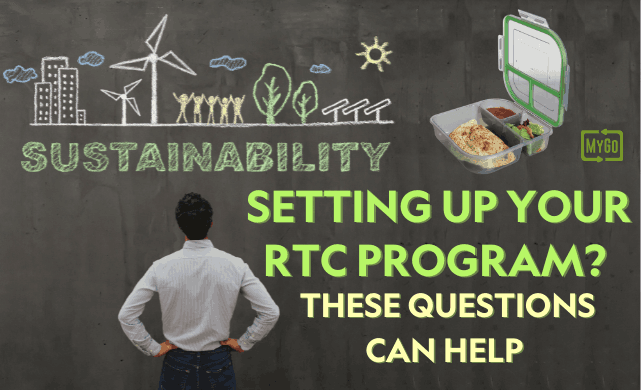Reusable To-Go Containers (RTC) have been part of college and university dining services for more than a decade. Over this time, a few manufacturers have become quite well-known and easily accessible, with MyGo Containersâ„¢ being a relatively recent addition to the market.
Even though institutions of higher education have been using RTCs in their foodservice operations for over ten years, the pandemic has dramatically increased interest in these solutions. The need to package meals for takeout, which would usually be consumed on-site, has highlighted the environmental impact of single-use food packaging and brought attention to the significant amount of waste created by disposable to-go containers in dining operations. Many colleges and universities are now considering launching new RTC programs or expanding existing ones that haven't yet reached their full potential. One of the most frequent discussions at regional NACUFS conferences was how to effectively set up an RTC program.
This is indeed a critical question! There are numerous factors to consider when designing an RTC program tailored to a specific facility. Initially, we thought our primary role would be assisting schools in deciding whether they needed larger 3-compartment MyGo Containers or the smaller versions. However, this seems to be among the simpler questions schools face. Given the uniqueness of each school in terms of foodservice operations, layout, meal plan options, student demographics, and priorities, we don’t think a one-size-fits-all approach is suitable. Nonetheless, we are equipped to help you develop an RTC program that will resonate with your students and align with your organization’s objectives.
To kickstart the creation of the perfect RTC program for your campus, here are some guiding questions to help build a robust, sustainable initiative:
• What styles or types of reusable to-go containers should you offer in your dining halls or foodservice outlets?
• How many containers will be needed daily to meet anticipated demand? Where will these containers be stored?
• Where should return collection receptacles be placed to ensure ease of access for participants?
• Who will be responsible for collecting used containers from the collection points?
• Who will handle the cleaning of the containers, where will the cleaned containers be stored, and who will ensure proper storage?
• What training is necessary for your RTC program, how will it be implemented, and who will oversee it?
• When will containers be made available to students?
• What accountability system will be implemented? If a deposit is collected from students, how much will it be, and what will be provided in return?
• Who will manage and monitor the accountability system?
• How will staff be held accountable for thoroughly cleaning and sanitizing used containers?
• Where do you expect theft to occur, and what measures can be taken to prevent it?
• How will you educate your student body and other customers about the benefits of your new RTC program?
• Who will lead the marketing and education efforts regarding the program? Is there a budget allocated for supporting the program?
• What does success look like for all stakeholders?
While answering these questions won’t provide a complete RTC program, they will help establish a framework that can be fleshed out with detailed plans as you address each question. For additional support in launching an RTC program at your school or facility, Cook’s is here with MyGo Containers™ and extensive experience helping other colleges, universities, and schools implement successful RTC programs that are both financially viable for the dining operation and supportive of sustainability initiatives.

Keywords:RTC PROGRAM
Custom Table Calendar,Printed Desk Calendar,Customizable Desk Calendar,Desk Calendar Printing,Custom Desktop Calendar
Guangzhou Xinqicai Printing Co., Ltd. , https://www.cnxqcprinting.com




